Asus ROG Zephyrus S GX701GXR detailed review
Asus’s Republic of Gamers has suddenly become very active in the Indian market, releasing machines at a pace that the market hasn’t seen before from the brand. Of the new machines launched, we have the company’s Asus ROG Zephyrus S (GX701), a 17-inch gaming laptop with some very impressive specifications. It packs an 8th generation Intel Core i7-8750H along with 24 gigs of RAM and an Nvidia RTX 2080 Max-Q. all of this is fitted into a laptop that’s less than an inch thick, which is no doubt, impressive. However, is it Rs 3,49,990 impressive? We find out.
Specifications
| ASUS ROG Zephyrus S (GX701) Specifications | |
| Processor | Intel Core i7-8750H 2.2 GHz |
| Platform | 300-series |
| RAM FSB | 2666 MHz |
| RAM Capacity | 24 GB |
| Screen Size | 17–inches |
| Screen Resolution | 1920x1080 |
| Refresh Rate | 144Hz |
| GPU | Nvidia GeForce RTX 2080 Max-Q |
| Storage | 1TB NVMe |
| Ethernet | None |
| Wi-Fi | Intel Wireless-AC 9560 (a/b/g/n/ac) |
| Battery | 76Whr |
| AC Adapter | 230W |
| Weight | 2.7 Kg |
Build and Design
The Asus Zephyrus S (GX701) has a very similar build to the Asus ROG Zephyrus S (GX531) that we had reviewed earlier. The 17-inch laptop surprisingly isn’t as big as we had assumed, measuring less than an inch in thickness overall. Asus also gave the display slip bezels so as to reduce the overall form-factor in comparison to that of a traditional 17-inch laptop. Asus claims that the laptop almost feels like a 15-inch machine, but let us assure you, it most definitely does not. I’ve had trouble fitting the GX701 into backpacks made for 15-inch laptops, including a massive camera backpack that easily holds the fatter ScarII (Review) from Asus.

The Asus ROG Zephyrus S is less than an inch thick
The lid has a lot less flex in comparison to the GX531, despite being made of more or less the same materials. You get the signature ROG dual-tone finish on the lid with an RGB adorned ROG logo. The display panel doesn’t come with a webcam, something that we’re not too bothered about anyway. Moving lower, we see the same over-extended keyboard layout, with Asus placing a grille on the top half of the keyboard island. Underneath this grille, Asus has placed the 12V fans for cooling, and they say this kind of layout eliminates the problem of heating on the keyboard altogether. Since the keyboard is now placed at the very edge of the base, the trackpad sits on the right side of the machine, a convenient position if you ask us.
The build quality of the Zephyrus S GX701 is absolutely rock solid while it is closed. When you open the laptop, a small plate at the bottom lifts up to create an opening for improved airflow. This, Asus calls their Active Aerodynamic System, which helps improve airflow. The only downside is that this bottom plate, while held by very sturdy hinges on the sides, is extremely thin and bends very easily. Holding the laptop with my hands anywhere on the plate (with the laptop open) caused it to bend and buckle significantly. I see the plate warping as a possibility with extended use.
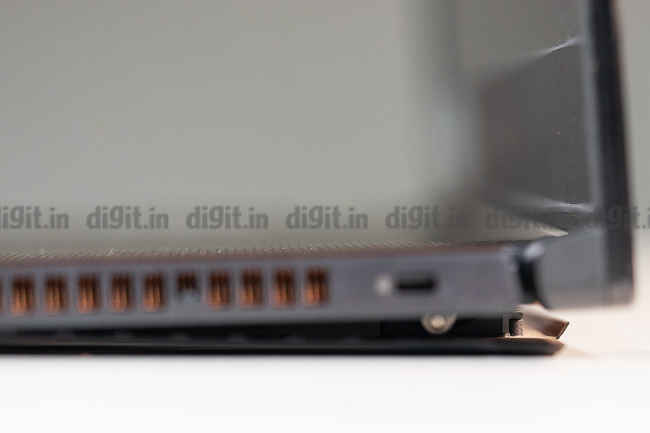
The bottom plate that lifts up create a gap for airflow is flimsy
Keyboard, Trackpad and I/O
The keyboard on the Asus Zephyrus S (GX701) offers 1.4mm of travel, 0.2mm more than what’s on the GX531 (Review) and surprisingly, it does make a difference. The keystrokes are firm, with good rebound, but if you are used to slightly longer travel (like in the 1.8mm range) it may take you a while before you get used to the keyboard. You also get per-key RGB support via the Asus Armory Crate software, which also offers a number of lighting effects you can choose from, in case you’re lazy like me. The keys are flat at the top which may seem like a minor detail, but once you’ve become used to typing on keys that have a slight curvature, flat keys really do stand out, and not in a good way. This is going to be a completely personal preference, but I wasn’t very pleased with the flat tops.+

The keyboard offers per-key RGB lighting
The trackpad is a vertically placed unit with individual left and right click buttons, that are soft to press. The trackpad also doubles up as the num-pad, switching between the two with the press of a button. In num-pad mode, there is no feedback when you strike a key and that can be a little unnerving. The lack of feedback made me just use the regular number keys instead of switching the trackpad to the num-pad.
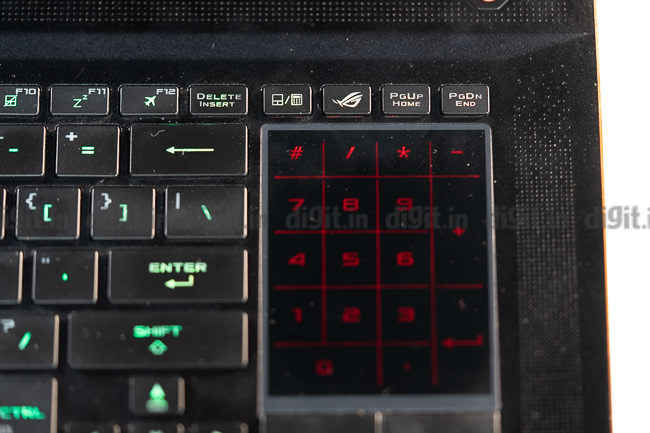
The 17-inch Zephyrus S sure offers a unique trackpad
In terms of the I/O, the GX701 offers a rather mature selection of ports. You get 2 USB 3.1 Gen 1 ports and one USB 3.1 Gen2 port with Type A connectors. There’s a USB 3.1 Gen 2 Type-C port with DisplayPort 1.2 compatibility and also a full size HDMI 2.0b port. As far as I/O goes, the GX701 doesn’t skimp out. We would have loved to see Thunderbolt 3 on this machine as well for greater flexibility and versatility, and do feel a little sad that for a machine that costs Rs 3,49,990, we don’t get Thunderbolt.
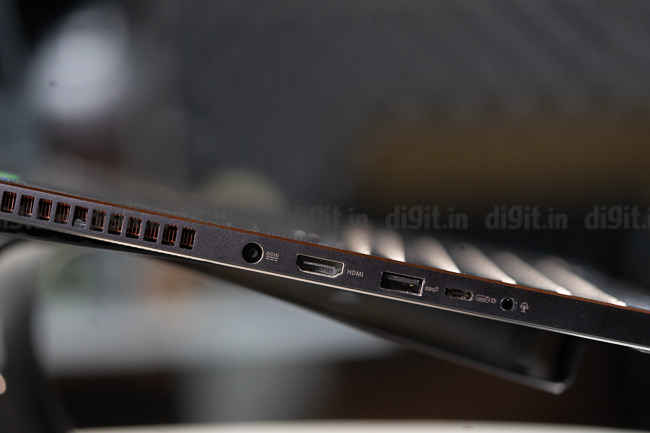
The Zephyrus S comes with a generous selection of I/O
While we like the overall experience of the keyboard, trackpad and I/O, with the only minor issues arising out of sheer preference rather than performance. But for sure, the lack of a Thunderbolt port is definitely felt.
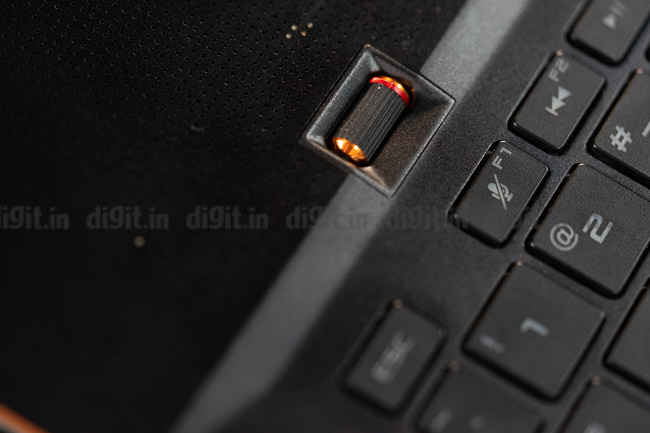
This little volume knob is actually really useful
Display
A big feature of the Asus ROG Zephyrus S (GX701) is its display. Featuring 1920x1080 pixels worth of resolution, the display is also Pantone certified and also supports Nvidia’s G-Sync. The last bit is interesting. Asus has developed a proprietary method for allowing the GX701 to switch between the G-Synch and Optimus modes that give you the best of both the worlds, but only one at a time. A quick restart engages the mode of your choice.
We measured the display’s accuracy, given that it is Pantone certified. Our Spyder colourimeter returned some impressive results. For starters, the display was calibrated right out of the box and was able to represent 100 percent of the sRGB space. The Adobe RGB coverage was lower, but it's not going to be a big deal.
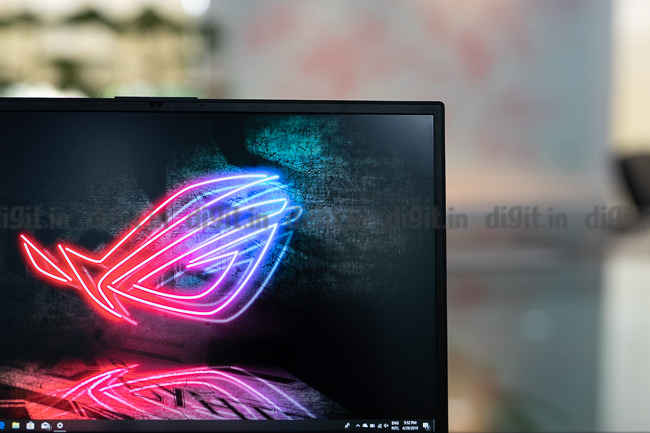
Pantone certified, G-Sync enabled and with 144Hz refresh rate. What's not to love?
The panel does have a slight light bleed, typical of IPS displays but it does not bleed over to real-world usage. Whether it was the dark corridors of Doom or the shots of outer space in Guardians of the Galaxy, the light bleed did not impact the viewing experience.
When gaming, having G-sync on the display does elevate the experience. Just for kicks, we turned the settings down on Doom to see if we’d face any tearing as the GX 701 pushed the game north of 130 fps and found that with G-Sync turned on, there was no tearing whatsoever. G-syn works as advertised, obviously, but even with the feature turned off, there’s not a lot of tearing that’s visible.
For watching movies or editing them, the colour accuracy of the panel will definitely be an asset. For gamers too, the only thing better would be a panel with the same Pantone certification, G-Sync, but with a 240Hz refresh rate and 1ms response time. But for now, the GX701 still rocks a pretty solid display.
Performance
Packing an Intel Core i7-8750H mated with the Nvidia GeForce RTX 2080 Max-Q, the Asus ROG Zephyrus S (GX701) is a pretty well spec’d out machine. There’s 24GB of RAM on-board (the max supported) along with a 1TB NVMe drive using 4 PCIe lanes. The laptop doesn’t offer any scope for upgrading since the RAM is maxed out and putting another NVMe drive or a larger drive wouldn’t be economically viable after spending Rs 3,49,990. Given that this is the first GeForce RTX 2080 equipped, we were pretty excited to figure out just how far it would push the frame rates on some of the more demanding games out there. But first, lets go over some of the benchmark numbers.
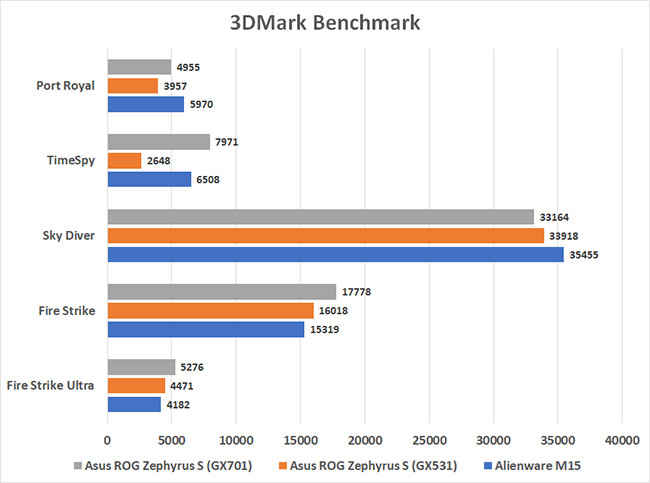
As the chart above shows, the GX701 outperforms all of the more recent laptops we’ve tested on most of 3DMark benchmark. We see it stutter on SkyDiver and Port Royale This cou;ld simply be a driver optimisation issue, but we went ahead and checked the system's gaming performance to see where it lands..
When it comes to gaming, we again see numbers that are, for the most part, higher than what we have seen so far, with a few minor exceptions. Below are the frame-rates for the GX701 alone.
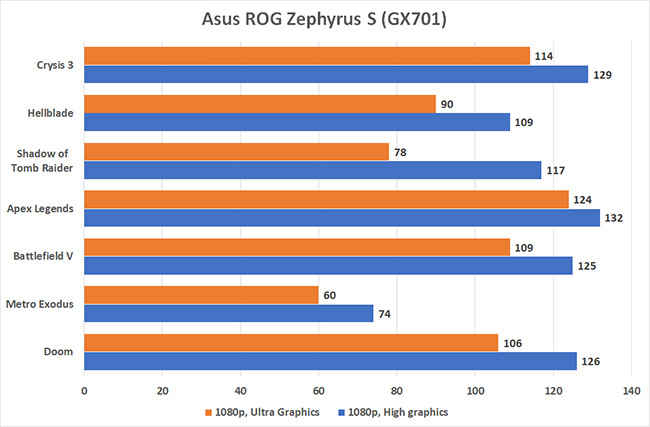
Gaming on the 17-inch Zephyrus S is an absolute treat
In addition, we’re also adding the frame-rate numbers for the RTX 2080 (Max-Q) powered GX701 alongside laptops with the RTX 2070 (Max-Q) and the RTX 2060. This is by no means an apples-to-apples comparison, but it gives you a realistic view of what kind of gaming performance you can get from machines that exist in the market today.
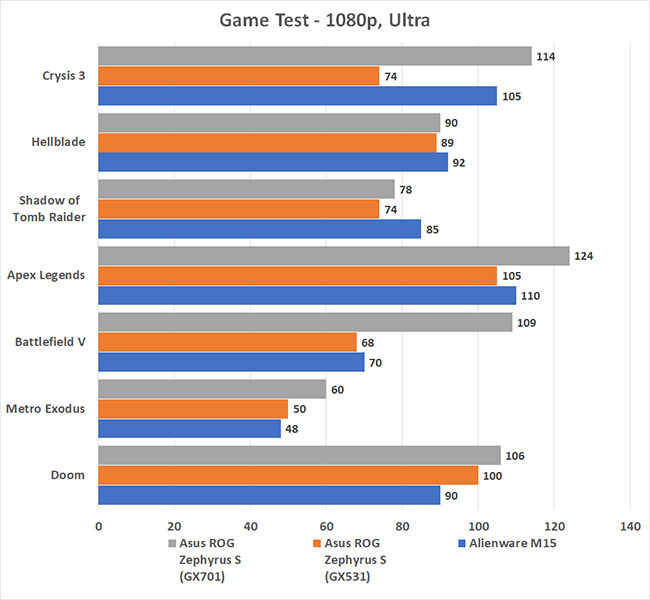
Playing some of our favourites on Ultra graphics
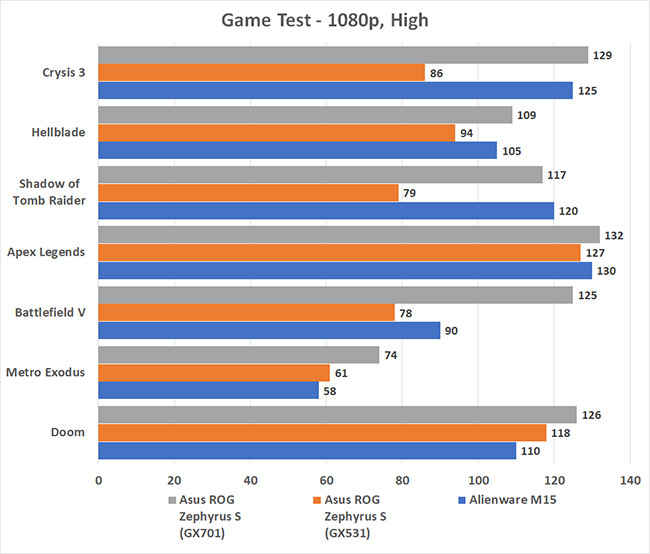
The 17-inch Zephyrus stays ahead of the pack
Suffice to say, the GX701 slices through all games like a nice warm knife through butter. We didn’t see any games reach the 144fps mark on top two highest graphics settings, but with much tweaking, it is something that could be achieved on some games. Except for Metro: Exodus. That game was built to shame powerful hardware.
Creative professionals would love the hardware here as well, with enough power to help you chew through hundred of high-resolution RAW files in Lightroom. For the video editors, you won’t have problems editing your 4K files using 1080p proxies with multiple LUTs applied. Scrubbing and preview playback in Adobe Premiere is smooth. Rendering a 10-minute edit into 4K x265 output several times didn’t cause the system or Premiere’s Media encoder to hang even once, which is pretty commendable. You look at the price tag of this machine and wonder if it will deliver on the promise of performance, and we’re happy to say that for the most part, it really does.
Thermals
The Asus ROG Zephyrus S (GX701) sports some really powerful components, which generate a lot of heat. The 12Volt fans spin up really fast when the system is set to Turbo from the Armory Crate software, and use the vents on the sides and the back for improved airflow. We noted that the top half of the keyboard island reach a peak temperature of 42-degrees when under full load while the side vents were recorded to exhaust heat at just 38.5 degrees. The WASD keys themselves stayed at just about 30 degrees, under load.
While the top stays cool, you will feel the heat on the bottom side, defying the “lap” part of a laptop. Things get really hot on the bottom side and its difficult t work with this beast sitting in your lap. Thankfully, we didn’t encounter any issues with thermal throttling, which bodes well for the GX701.
Asus’s Republic of Gamers has suddenly become very active in the Indian market, releasing machines at a pace that the market hasn’t seen before from the brand. Of the new machines launched, we have the company’s Asus ROG Zephyrus S (GX701), a 17-inch gaming laptop with some very impressive specifications. It packs an 8th generation Intel Core i7-8750H along with 24 gigs of RAM and an Nvidia RTX 2080 Max-Q. all of this is fitted into a laptop that’s less than an inch thick, which is no doubt, impressive. However, is it Rs 3,49,990 impressive? We find out.
Specifications
| ASUS ROG Zephyrus S (GX701) Specifications | |
| Processor | Intel Core i7-8750H 2.2 GHz |
| Platform | 300-series |
| RAM FSB | 2666 MHz |
| RAM Capacity | 24 GB |
| Screen Size | 17–inches |
| Screen Resolution | 1920x1080 |
| Refresh Rate | 144Hz |
| GPU | Nvidia GeForce RTX 2080 Max-Q |
| Storage | 1TB NVMe |
| Ethernet | None |
| Wi-Fi | Intel Wireless-AC 9560 (a/b/g/n/ac) |
| Battery | 76Whr |
| AC Adapter | 230W |
| Weight | 2.7 Kg |
Build and Design
The Asus Zephyrus S (GX701) has a very similar build to the Asus ROG Zephyrus S (GX531) that we had reviewed earlier. The 17-inch laptop surprisingly isn’t as big as we had assumed, measuring less than an inch in thickness overall. Asus also gave the display slip bezels so as to reduce the overall form-factor in comparison to that of a traditional 17-inch laptop. Asus claims that the laptop almost feels like a 15-inch machine, but let us assure you, it most definitely does not. I’ve had trouble fitting the GX701 into backpacks made for 15-inch laptops, including a massive camera backpack that easily holds the fatter ScarII (Review) from Asus.

The Asus ROG Zephyrus S is less than an inch thick
The lid has a lot less flex in comparison to the GX531, despite being made of more or less the same materials. You get the signature ROG dual-tone finish on the lid with an RGB adorned ROG logo. The display panel doesn’t come with a webcam, something that we’re not too bothered about anyway. Moving lower, we see the same over-extended keyboard layout, with Asus placing a grille on the top half of the keyboard island. Underneath this grille, Asus has placed the 12V fans for cooling, and they say this kind of layout eliminates the problem of heating on the keyboard altogether. Since the keyboard is now placed at the very edge of the base, the trackpad sits on the right side of the machine, a convenient position if you ask us.
The build quality of the Zephyrus S GX701 is absolutely rock solid while it is closed. When you open the laptop, a small plate at the bottom lifts up to create an opening for improved airflow. This, Asus calls their Active Aerodynamic System, which helps improve airflow. The only downside is that this bottom plate, while held by very sturdy hinges on the sides, is extremely thin and bends very easily. Holding the laptop with my hands anywhere on the plate (with the laptop open) caused it to bend and buckle significantly. I see the plate warping as a possibility with extended use.

The bottom plate that lifts up create a gap for airflow is flimsy
Keyboard, Trackpad and I/O
The keyboard on the Asus Zephyrus S (GX701) offers 1.4mm of travel, 0.2mm more than what’s on the GX531 (Review) and surprisingly, it does make a difference. The keystrokes are firm, with good rebound, but if you are used to slightly longer travel (like in the 1.8mm range) it may take you a while before you get used to the keyboard. You also get per-key RGB support via the Asus Armory Crate software, which also offers a number of lighting effects you can choose from, in case you’re lazy like me. The keys are flat at the top which may seem like a minor detail, but once you’ve become used to typing on keys that have a slight curvature, flat keys really do stand out, and not in a good way. This is going to be a completely personal preference, but I wasn’t very pleased with the flat tops.+

The keyboard offers per-key RGB lighting
The trackpad is a vertically placed unit with individual left and right click buttons, that are soft to press. The trackpad also doubles up as the num-pad, switching between the two with the press of a button. In num-pad mode, there is no feedback when you strike a key and that can be a little unnerving. The lack of feedback made me just use the regular number keys instead of switching the trackpad to the num-pad.

The 17-inch Zephyrus S sure offers a unique trackpad
In terms of the I/O, the GX701 offers a rather mature selection of ports. You get 2 USB 3.1 Gen 1 ports and one USB 3.1 Gen2 port with Type A connectors. There’s a USB 3.1 Gen 2 Type-C port with DisplayPort 1.2 compatibility and also a full size HDMI 2.0b port. As far as I/O goes, the GX701 doesn’t skimp out. We would have loved to see Thunderbolt 3 on this machine as well for greater flexibility and versatility, and do feel a little sad that for a machine that costs Rs 3,49,990, we don’t get Thunderbolt.

The Zephyrus S comes with a generous selection of I/O
While we like the overall experience of the keyboard, trackpad and I/O, with the only minor issues arising out of sheer preference rather than performance. But for sure, the lack of a Thunderbolt port is definitely felt.

This little volume knob is actually really useful
A big feature of the Asus ROG Zephyrus S (GX701) is its display. Featuring 1920x1080 pixels worth of resolution, the display is also Pantone certified and also supports Nvidia’s G-Sync. The last bit is interesting. Asus has developed a proprietary method for allowing the GX701 to switch between the G-Synch and Optimus modes that give you the best of both the worlds, but only one at a time. A quick restart engages the mode of your choice.
Display
We measured the display’s accuracy, given that it is Pantone certified. Our Spyder colourimeter returned some impressive results. For starters, the display was calibrated right out of the box and was able to represent 100 percent of the sRGB space. The Adobe RGB coverage was lower, but it's not going to be a big deal.

Pantone certified, G-Sync enabled and with 144Hz refresh rate. What's not to love?
The panel does have a slight light bleed, typical of IPS displays but it does not bleed over to real-world usage. Whether it was the dark corridors of Doom or the shots of outer space in Guardians of the Galaxy, the light bleed did not impact the viewing experience.
When gaming, having G-sync on the display does elevate the experience. Just for kicks, we turned the settings down on Doom to see if we’d face any tearing as the GX 701 pushed the game north of 130 fps and found that with G-Sync turned on, there was no tearing whatsoever. G-syn works as advertised, obviously, but even with the feature turned off, there’s not a lot of tearing that’s visible.
For watching movies or editing them, the colour accuracy of the panel will definitely be an asset. For gamers too, the only thing better would be a panel with the same Pantone certification, G-Sync, but with a 240Hz refresh rate and 1ms response time. But for now, the GX701 still rocks a pretty solid display.
Performance and Gaming
Packing an Intel Core i7-8750H mated with the Nvidia GeForce RTX 2080 Max-Q, the Asus ROG Zephyrus S (GX701) is a pretty well spec’d out machine. There’s 24GB of RAM on-board (the max supported) along with a 1TB NVMe drive using 4 PCIe lanes. The laptop doesn’t offer any scope for upgrading since the RAM is maxed out and putting another NVMe drive or a larger drive wouldn’t be economically viable after spending Rs 3,49,990. Given that this is the first GeForce RTX 2080 equipped, we were pretty excited to figure out just how far it would push the frame rates on some of the more demanding games out there. But first, let's go over some of the benchmark numbers.

As the chart above shows, the GX701 outperforms all of the more recent laptops we’ve tested on most of 3DMark benchmark. We see it stutter on SkyDiver and Port Royale This cou;ld simply be a driver optimisation issue, but we went ahead and checked the system's gaming performance to see where it lands.
When it comes to gaming, we again see numbers that are, for the most part, higher than what we have seen so far, with a few minor exceptions. Below are the frame-rates for the GX701 alone.

Gaming on the 17-inch Zephyrus S is an absolute treat
In addition, we’re also adding the frame-rate numbers for the RTX 2080 (Max-Q) powered GX701 alongside laptops with the RTX 2070 (Max-Q) and the RTX 2060. This is by no means an apples-to-apples comparison, but it gives you a realistic view of what kind of gaming performance you can get from machines that exist in the market today.

Playing some of our favourites on Ultra graphics

The 17-inch Zephyrus stays ahead of the pack
Suffice to say, the GX701 slices through all games like a nice warm knife through butter. We didn’t see any games reach the 144fps mark on top two highest graphics settings, but with much tweaking, it is something that could be achieved on some games. Except for Metro: Exodus. That game was built to shame powerful hardware.
Creative professionals would love the hardware here as well, with enough power to help you chew through hundred of high-resolution RAW files in Lightroom. For the video editors, you won’t have problems editing your 4K files using 1080p proxies with multiple LUTs applied. Scrubbing and preview playback in Adobe Premiere is smooth. Rendering a 10-minute edit into 4K x265 output several times didn’t cause the system or Premiere’s Media encoder to hang even once, which is pretty commendable. You look at the price tag of this machine and wonder if it will deliver on the promise of performance, and we’re happy to say that for the most part, it really does.
The Asus ROG Zephyrus S (GX701) sports some really powerful components, which generate a lot of heat. The 12Volt fans spin up really fast when the system is set to Turbo from the Armory Crate software, and use the vents on the sides and the back for improved airflow. We noted that the top half of the keyboard island reach a peak temperature of 42-degrees when under full load while the side vents were recorded to exhaust heat at just 38.5 degrees. The WASD keys themselves stayed at just about 30 degrees, under load.
While the top stays cool, you will feel the heat on the bottom side, defying the “lap” part of a laptop. Things get really hot on the bottom side and its difficult t work with this beast sitting in your lap. Thankfully, we didn’t encounter any issues with thermal throttling, which bodes well for the GX701.
Battery Life
Sporting a 76Whr battery and an Optimus mode for “better” battery life. Well, in our use, the laptop lasted roughly two and a half hours on battery while doping regular office work with light image editing in photoshop. On the PCMark 8 Battery test, the laptop lasted just about 2 hours and 48 minutes, a small number by most accounts, but definitely expected from a gaming beast like this one. If you’re looking to maximise the usability of this machine n battery, you’re going to find yourself turning off features and lowering the brightness mostly to a minimum. Not to mention, G Sync will wreak havoc on the battery life. All I’m saying is that the Asus GX701, which is designed for heavy gaming and photo/video editing, won’t be able to function as such on battery life alone.
Bottomline
Let’s be very clear about one thing. The Asus ROG Zephyrus S (GX701) is not a desktop replacement by any means. For the price, you can get a more powerful desktop, with a larger, and equally adept (if not better) monitor. This is a machine for the gamer or creator who is constantly on the move. It's for someone who’s ready to throw down into a game of Call of Duty anywhere, anytime, as long as they remember to carry the 230W power brick. The minor inconvenience of carrying the GX701 around is compensated for by the reliable performance offered by this really expensive laptop. The question of should you buy this is only answered by your needs, but with little room for any further upgrades, we do worry about the longevity of the machine.
[embed]https://www.youtube.com/watch?v=p0DmTpelfPo[/embed][ad_2]
Source link

Post a Comment